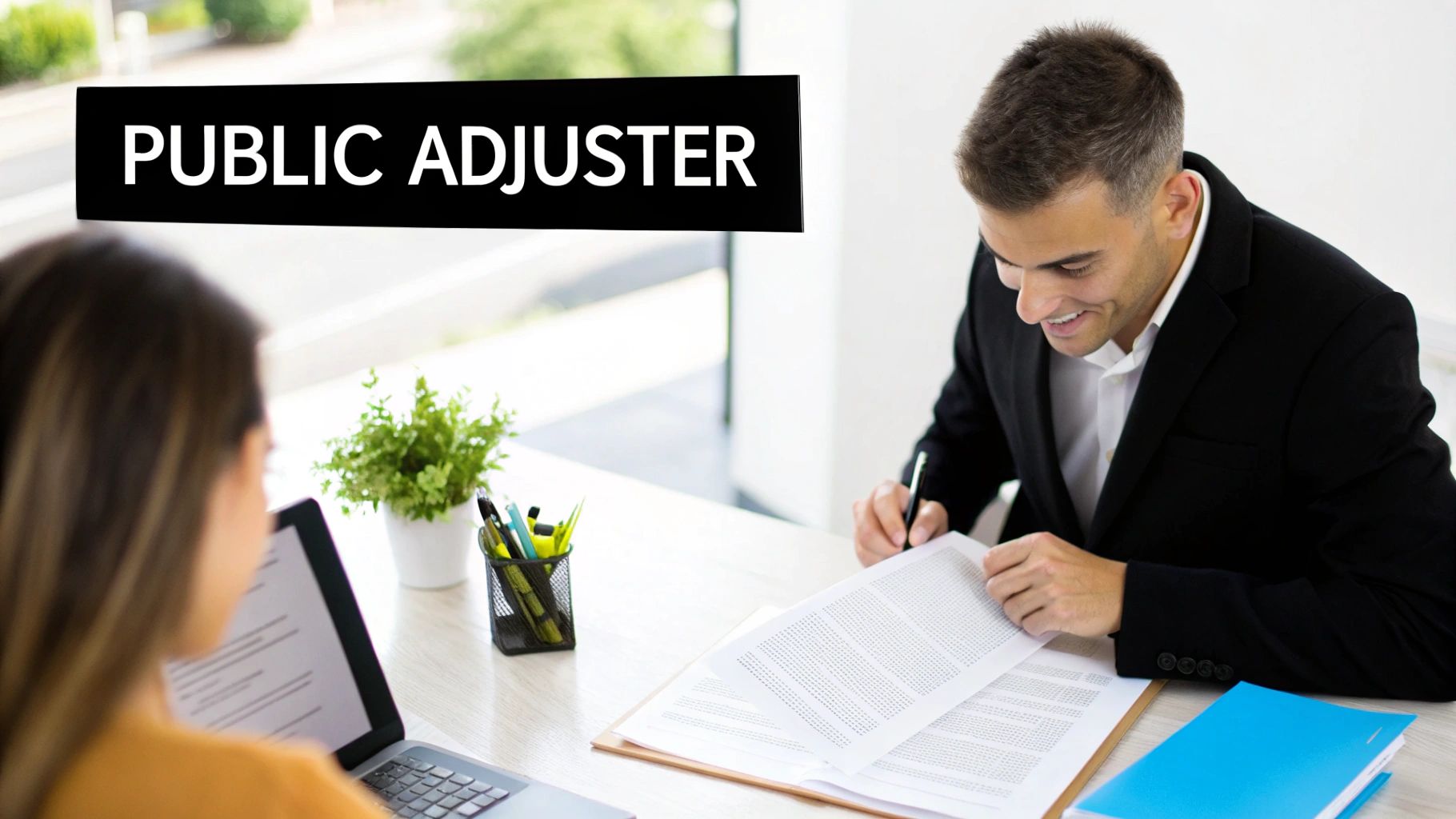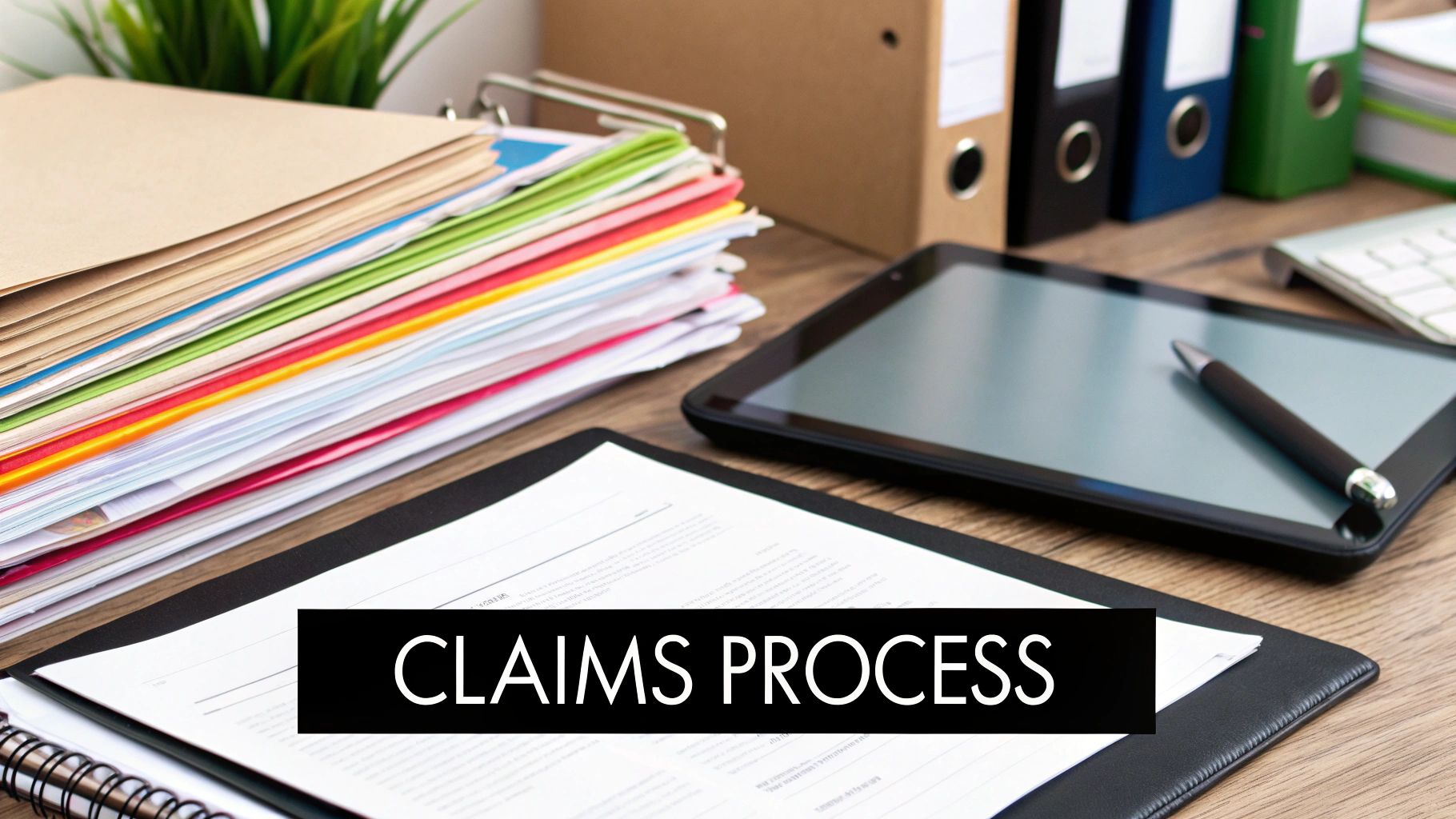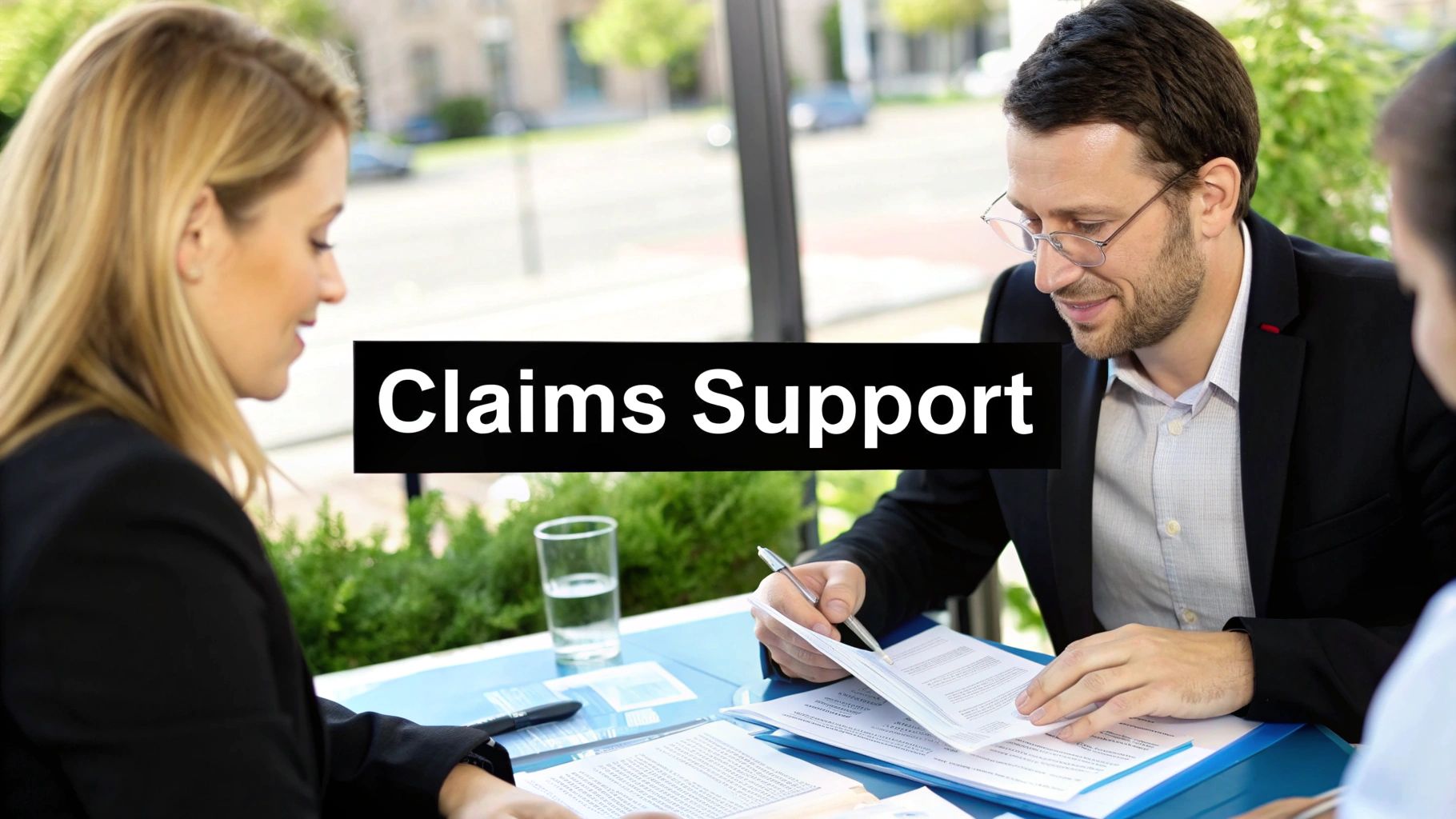Decoding the Public Adjuster Meaning: Your Insurance Ally

Understanding the meaning of "public adjuster" is crucial for anyone navigating the complexities of insurance claims. This term can often get confusing, but its importance is clear, especially after a significant property loss. A public adjuster is your advocate in the claims process, working to get you a fair settlement. This differs greatly from the role of an insurance company adjuster. Understanding this difference is key to understanding what a public adjuster is.
A public adjuster is a licensed professional working solely for the policyholder, not the insurance company. This is a vital distinction. Company adjusters primarily protect the insurer’s bottom line. This can mean minimizing payouts, sometimes leaving policyholders with less than they deserve. In a fire damage claim, for instance, a company adjuster might undervalue replacing damaged items. A public adjuster would thoroughly document each item and its replacement value to ensure you receive full compensation.
A public adjuster is an independent insurance professional licensed state-by-state representing the policyholder, not the insurance company, during the claims process. They evaluate damage, interpret insurance policies, and negotiate with insurers. Unlike insurance company adjusters, public adjusters work exclusively for the policyholder, ensuring fair claims handling and maximum compensation.
This difference is crucial. Insurance adjusters sometimes undervalue claims, potentially denying valid ones or offering low settlements. Public adjusters level the playing field, especially in complex claims from fire, theft, plumbing issues, or severe weather. They help policyholders avoid low offers and reduce out-of-pocket expenses from insufficient settlements. According to the Insurance Information Institute and industry experts, over 5% of insured homes filed claims in 2021, highlighting the frequency of claims and the need for effective representation.
What Does a Public Adjuster Do?
Public adjusters handle numerous tasks throughout the claims process. They go beyond simply assessing damage; they act as your advisor, guiding you and protecting your interests. This involves understanding often-complex insurance policies. They decipher the fine print to identify coverage you might not know you have.
-
Damage Evaluation: Public adjusters conduct thorough inspections, documenting the full extent of property damage. This detailed documentation is key evidence for your claim.
-
Policy Interpretation: Understanding insurance policies is a core part of their role. They identify all applicable coverage and explain your rights under the policy.
-
Claim Negotiation: This is where their expertise truly benefits you. Using detailed documentation and policy knowledge, they negotiate with the insurance company to maximize your settlement.
-
Documentation and Paperwork: They handle all the necessary paperwork, reducing your burden during a stressful time.
For a deeper understanding of homeowners insurance and how a public adjuster can help, check out this guide: Decoding Homeowners Insurance: Understanding Your Coverage. Public adjusters provide policyholders with a strong advocate, ensuring fair treatment. Their knowledge and experience can significantly impact your claim's outcome, helping you recover what you're owed.
The Crucial Difference: Public vs. Insurance Company Adjusters

Understanding what a public adjuster is hinges on one key difference: who they represent. Unlike adjusters employed by insurance companies, public adjusters work exclusively for the policyholder. This distinction has significant implications for your claim outcome. Think of it like legal representation; you wouldn’t want to rely solely on the opposing counsel's advice in court.
Conflicting Incentives: Who’s On Your Side?
Insurance company adjusters, while often courteous, work for the insurance company. Their goal is to minimize the insurer’s payout. This isn't necessarily malicious; it's simply their job. Their performance is often tied to cost containment. Public adjusters, however, work solely for you. Their incentive is to maximize your claim, ensuring you receive every dollar you're entitled to.
Imagine a hailstorm damages your roof. A company adjuster might offer a settlement for partial repairs. A public adjuster, on the other hand, would thoroughly document all damage, including hidden problems, and negotiate for a full replacement if warranted by your policy. This difference in advocacy can result in a significantly larger settlement.
Understanding Tactics: How Claims Can Be Undervalued
Insurance companies sometimes use tactics to minimize payouts. These may include downplaying damage, disputing the cause of loss, or offering lowball settlements. Public adjusters are well-versed in these tactics and know how to counter them. They understand complex policy language, document damage effectively, and build a strong case for maximum compensation.
Public adjusters also recognize the emotional stress associated with property loss. They handle the paperwork and negotiations, allowing you to focus on recovery. This support is invaluable during a difficult time.
The Power of Advocacy: Leveling the Playing Field
Even well-intentioned company adjusters operate within a system designed to protect insurance company profits. This inherent conflict of interest highlights the importance of having your own advocate. A public adjuster shifts the power dynamic. They ensure your voice is heard and your interests are protected, working towards a fair settlement.
To further illustrate these key differences, take a look at the following comparison:
Public Adjusters vs. Insurance Company Adjusters
A side-by-side comparison of key differences between public adjusters and insurance company adjusters to help readers understand their distinct roles, responsibilities, and loyalties.
| Factor | Public Adjuster | Insurance Company Adjuster |
|---|---|---|
| Who they represent | Policyholder | Insurance Company |
| Incentive | Maximize your settlement | Minimize the insurer's payout |
| Loyalty | You | The insurance company |
| Expertise | Negotiating for the policyholder | Protecting the insurer's interests |
As this table clearly shows, having a public adjuster on your side can significantly impact your claim outcome. By hiring a public adjuster, you gain a dedicated advocate who will fight for your best interests and help you receive the maximum compensation you deserve under your policy. This professional representation can make a substantial difference in your financial recovery after a loss.
The Financial Impact: Are Public Adjusters Worth Their Fee?

Many policyholders wonder if hiring a public adjuster is truly worth the cost. Does the potential increase in their claim settlement outweigh the adjuster's fee? In many cases, the answer is yes. Studies and real-world examples consistently show the financial advantages of using a public adjuster. It's not just about recovering losses; it's about receiving the full amount you're entitled to under your policy.
Understanding the Contingency Fee Model
Most public adjusters work on a contingency fee basis. This means their fee is a percentage of your final settlement. If there's no recovery, there's no fee. This arrangement aligns the adjuster's goals with yours. Their success depends on your success, motivating them to negotiate the highest possible settlement.
This model also eliminates upfront costs. This makes professional assistance available to more policyholders. The contingency arrangement shifts the financial risk away from you. You pay only if and when you receive money from your insurance company.
For example, if a public adjuster negotiates a $50,000 settlement and their fee is 10%, they would receive $5,000, and you would receive $45,000. While $5,000 might seem like a lot, consider this: without the adjuster, you might have only received $10,000 from the insurer. This would leave you with a net of $10,000 compared to $45,000 with the adjuster's help.
Analyzing Real-World Settlement Outcomes
The positive effect of public adjusters can be substantial. Data shows a notable increase in claim payments when policyholders have professional representation. A study in Florida found that catastrophic claims saw an average increase of 747% with a public adjuster. Non-catastrophic claims were 574% higher.
While claims did take longer to settle with a public adjuster, the greater financial gains more than compensated for the additional time. These results emphasize the value of hiring a public adjuster, particularly with complex property losses. The increased payouts likely reflect the adjuster’s skill in interpreting policies and negotiating settlements. You can find more detailed statistics here.
Calculating the True ROI of Professional Representation
The real return on investment (ROI) is calculated by comparing your net payout with and without a public adjuster. Let’s look at an example involving fire damage. The insurance company initially offered the homeowner $20,000. The homeowner hired a public adjuster with a 10% fee. The adjuster negotiated a settlement of $60,000.
After the fee, the homeowner received $54,000, a net gain of $34,000. This demonstrates a significant ROI compared to the initial offer. For more information about insurance, you might find this article helpful: The Pros and Cons of Term vs. Whole Life Insurance.
Real Case Studies and Policyholder Testimonials
Real-life examples showcase the impact of professional representation. In one case, a homeowner dealing with a complex water damage claim initially received an offer of $8,000. After hiring a public adjuster, the final settlement reached $35,000, even after deducting the adjuster’s fee. These kinds of stories, common across various claim types, demonstrate the value of a public adjuster. They highlight not only the financial benefits but also the reduced stress of having an experienced advocate on your side.
The following table further illustrates the impact a public adjuster can have on various claim types:
Public Adjuster Impact on Claim Settlements
Statistical comparison showing the difference in average settlement amounts between claims with and without public adjuster representation across different types of property damage claims.
| Claim Type | Average Settlement Without Public Adjuster | Average Settlement With Public Adjuster | Percentage Increase |
|---|---|---|---|
| Fire Damage | $25,000 | $75,000 | 200% |
| Water Damage | $10,000 | $35,000 | 250% |
| Wind Damage | $15,000 | $50,000 | 233% |
| Theft/Vandalism | $5,000 | $18,000 | 260% |
As you can see, across the board, using a public adjuster leads to significantly higher settlements. While these numbers are averages, and individual results can vary, they demonstrate the potential for a substantial return on investment when engaging a public adjuster.
When to Bring in the Professionals: Signs You Need an Advocate

While filing an insurance claim is often straightforward, some situations benefit from professional guidance. Understanding the role of a public adjuster is important, especially when complexities arise. Knowing when their expertise is crucial can make a real difference in your financial recovery.
Significant or Complex Damage: Beyond DIY Handling
Extensive or complicated damage is a clear sign you might need a public adjuster. This could involve multiple damage types, like fire and water damage, or significant structural problems. Imagine a fire causing widespread smoke and water damage from firefighting efforts. Accurately assessing the full extent of the loss becomes a complex undertaking. A public adjuster's experience in these situations is invaluable. They ensure all damage is properly documented and included in your claim.
Disputed Liability or Cause of Loss: Navigating Uncertainty
Disagreements with your insurance company about the cause or coverage of damage warrant professional help. If your claim is denied or the damage is attributed to an uncovered cause, a public adjuster can advocate for you. For example, if your home floods after a hurricane and the insurer blames pre-existing issues, a public adjuster can investigate and provide evidence to support your side of the story.
Complex Policy Language or Coverage Disputes: Deciphering the Fine Print
Insurance policies can be difficult to understand. If you're facing disputes about coverage, a public adjuster can clarify the situation. They can help you navigate the intricacies of your policy and advocate for the maximum coverage you deserve. This is particularly helpful in complex scenarios with multiple coverage areas or disputes regarding policy exclusions.
Unreasonable Delays or Lowball Offers: Standing Your Ground
Unreasonable delays or low settlement offers from your insurance company are also red flags. A public adjuster can expedite the claims process and negotiate a fair settlement. For instance, if your claim is delayed for months without explanation, or the offer barely covers a fraction of the repairs, a public adjuster can intervene and push for timely action and a fair settlement.
Overwhelming Paperwork or Emotional Distress: Finding Support
The claims process can be overwhelming, especially after a traumatic event. If you're feeling stressed or emotionally drained, a public adjuster can offer support and guidance. They handle the paperwork, communications, and negotiations, allowing you to focus on your recovery. This is especially beneficial if you're coping with the loss of a loved one or displacement due to the damage.
Timing Is Key: Acting Promptly
Engaging a public adjuster early in the claims process is crucial. Their early involvement allows them to quickly begin documenting damage, assessing your policy, and building a strong case for your claim. Delaying can mean missed opportunities to maximize your recovery.
By recognizing these signs and understanding the value of professional advocacy, you can make an informed decision. A public adjuster's expertise can significantly impact your claim's outcome and help you secure the financial recovery you deserve.
Navigating the Licensing Landscape: Finding Qualified Help
The public adjusting profession protects policyholders during the often-complex insurance claims process. This profession operates under specific regulations and licensing requirements to ensure ethical conduct and professional competence. Understanding these licensing requirements is crucial for choosing a qualified public adjuster. This involves verifying their credentials and understanding their ethical obligations when handling your claim.
Understanding Licensing Requirements
Licensing requirements for public adjusters vary by state. Some states mandate rigorous testing and background checks, while others have less stringent requirements. This variance highlights the importance of verifying an adjuster's credentials in your specific location. For instance, some states require continuing education to maintain a license, ensuring adjusters stay current with evolving industry practices and regulations.
This formalization of the public adjuster role is a growing global trend. In the United States, this is particularly evident in states like Wisconsin. Effective July 1, 2020, the Office of the Commissioner of Insurance implemented specific registration and bonding requirements for public adjusters under Wisconsin Act 129. This act mandates state registration, continuing education, and ongoing reporting. While some exceptions exist, these regulations promote transparency and protect policyholders.
Verifying Credentials: Protecting Yourself From Fraud
Protecting yourself from fraudulent actors begins with verifying an adjuster’s credentials. Most states maintain online databases where you can confirm an adjuster's license status. This simple check can prevent costly mistakes and ensure you’re working with a legitimate professional. Also, check for membership in professional organizations, which often maintain their own ethical guidelines and standards.
Questions to Ask Before Hiring a Public Adjuster
Before signing a representation agreement, interview several adjusters. Ask about their experience handling claims similar to yours. Don't hesitate to inquire about their fee structure and estimated timeline for your type of claim. Transparency is essential. If you're facing difficulties navigating the complexities, consider consulting with a specialist, like a Veterans Claims Lawyer.
Understanding Fee Structures and Contracts
Public adjusters generally work on a contingency fee basis, meaning their fee is a percentage of your final settlement. It's crucial to understand this percentage upfront and verify it’s clearly stated in your contract. Carefully review the entire contract, focusing on the scope of services and any clauses regarding termination.
Your Rights as a Consumer
As a consumer, you have the right to a fair and transparent claims process. If you suspect an adjuster is acting unethically or misrepresenting their services, report them to your state's insurance department. You might also find helpful information in articles like: Navigating the Home Insurance Market: Tips for Finding the Best Policy in 2025. By understanding licensing requirements and asking pertinent questions, you can choose a qualified public adjuster to represent your best interests. This proactive approach will help you effectively navigate the claims process and secure a fair resolution.
Inside The Claims Process: What Happens After You Hire Help
Hiring a public adjuster can feel like a significant decision. Understanding the process—from the initial consultation to the final settlement—can ease your concerns and empower you to navigate your claim effectively. This section explains the work of a public adjuster, offering insight into their strategies and techniques for achieving optimal results. This knowledge helps you understand the true meaning of a public adjuster: your trusted advocate.
Initial Consultation and Damage Assessment
The process begins with a thorough consultation. The public adjuster meets with you to discuss the details of your loss, review your insurance policy, and answer your questions. This initial meeting establishes the foundation for their representation. They'll explain their fee structure, typically a percentage of the final settlement, and outline the next steps. This transparency ensures you're fully informed before proceeding.
After the consultation, the public adjuster conducts a comprehensive damage assessment. Unlike a company adjuster who might perform a quick assessment, a public adjuster meticulously documents every detail. This includes visible damage and potential hidden damage, like structural issues or water intrusion. This detailed assessment is crucial for a strong claim.
Policy Review and Coverage Analysis
Next, the public adjuster carefully reviews your insurance policy. This involves identifying all applicable coverage and any overlooked provisions. They are experts at deciphering complex insurance jargon and will explain your rights. This step is critical as many policyholders are unaware of their full coverage. Public adjusters can often uncover hidden benefits or clauses that significantly impact your settlement.
For example, if a tree falls on your house, your policy might cover debris removal and additional living expenses during repairs, in addition to structural damage repair costs. A public adjuster will ensure these additional coverages are included in your claim.
Documentation and Claim Preparation
The public adjuster then gathers all necessary documentation to support your claim. This can include photographs, videos, repair estimates, receipts, and other relevant evidence. They organize this information into a comprehensive claim package clearly demonstrating the extent of your loss and justifying the requested settlement amount. Meticulous documentation is essential for a compelling case.
Negotiation and Settlement Discussions
With the claim prepared, the public adjuster negotiates with the insurance company on your behalf. Their expertise in negotiation tactics and policy interpretation is key here. They will advocate for your best interests, pursuing a fair settlement reflecting your covered losses.
This negotiation process involves communication with the insurance company, presenting evidence, and countering arguments or lowball offers. The public adjuster keeps you informed, explaining each step and seeking your input on key decisions. They act as a buffer, allowing you to focus on recovery while they handle negotiations.
Claim Resolution and Final Settlement
The public adjuster's goal is to secure the maximum possible settlement. Once a settlement is reached, they review the terms with you to ensure your satisfaction. Upon your approval, the insurance company issues the final check. The adjuster deducts their agreed-upon fee, and you receive the remaining amount.
By understanding these steps and the dedication of a public adjuster, you can feel confident in your decision to seek professional assistance. Their expertise can significantly impact your financial recovery after a loss, providing financial benefits and peace of mind during a stressful time.
Comments are closed.